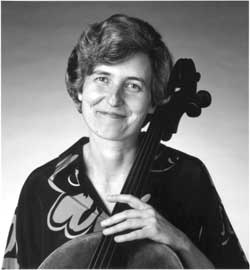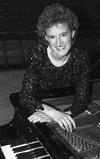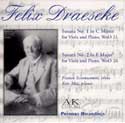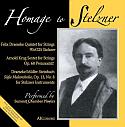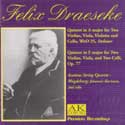THE TENTH ANNIVERSARY CELEBRATION OF THE
INTERNATIONAL DRAESEKE SOCIETY NORTH AMERICA
Presents
A SPECIAL 10TH ANNIVERSARY CONCERT OF MUSIC BY FELIX DRAESEKE
IN CONJUNCTION WITH THE PERFORMANCE COMMITTEE OF THE AMERICAN MUSICOLOGICAL SOCIETY, HOUSTON, TEXAS |
|
FELIX DRAESEKE SONATA NO. 2 in F MAJOR, for VIOLA ALTA 1st Movement: Bewegt Viola alta, James Przygocki - Pause - FELIX DRAESEKE QUINTET in A MAJOR for 2 VIOLINS, VIOLA , VIOLOTTA AND CELLO, STELZNER, Wo0 25 THE SUMMIT CHAMBER PLAYERS UNIVERSITY OF WYOMING 1st Violin, Javier Pinell All the instruments in this performance are genuine Stelzner products and this marks the first time that such an ensemble has been assembled on North American shores. The International Draeseke Society North America wishes to express its deepest gratitude for the dedicated and unflinching efforts of Dr. James Christensen, the world’s leading authority on Alfred Stelzner and Stelzner instrument design, in obtaining and making these instruments available to us.
Felix Draeseke was born in 1835 in the Franconian ducal town of Coburg, Germany. He was attracted to music earl and encountered no opposition from his family when, in his teens, he declared his intention of was won over to the New German School centered on Liszt at Weimar becoming a professional musician. A few years at the Leipzig Conservatory did not seem to benefit his development, but an early performance of Lohengrin, where he visited (arriving after the departure of Joachim Raff) and where he met Hans von Bülow and with whom he concluded a steadfast and lifelong friendship. Restless from 1857 to 1862 Draeseke visited many cities before settling in 1862 in a town near Lausanne in Switzerland following the debacle concerning Peter Cornelius’s opera Der Barbier von Bagdad and its consequences for Liszt. Upon his return to Germany in 1876, Draeseke chose Dresden as his During his life Draeseke was held in high regard, even among his musical opponents but, as Hans von Bülow once declared to him, he was a “harte Nuß” (“a tough nut to crack”) and despite the quality of his works, would “never be popular among the ordinary”. Draeseke could be sharply critical, even of allies and friends, and this sometimes led to strained relations, the most notorious instance being with Richard Strauss, when Draeseke attacked Strauss’s Salome in his 1905 pamphlet Die Konfusion in der Musik - a rather strange development because it is obvious now that Draeseke was a clear influence on the young Strauss. After his death his music, with the possible exceptions of the Gudrun Overture, the Serenade for Orchestra and his Third Symphony (Symphonia Tragica), disappeared from programs in Germany (they never gained the international attention they deserve) until finally his widow and some of his pupils decided to form a Felix Draeseke Gesellschaft (Felix Draeseke Society). The society’s founding occurred just as the Nazis were coming to power and, his biographer, Erich Roeder was a devoted party member and there is no doubt that a great number of performances of Draeseke’s music in the Third Reich were as much politically connected as musically justified by its merits. After the Second World War the Felix Draeseke Gesellschaft lingered on: Frida Draeseke had died in 1942, Eric Roeder had been killed in the war, and the remaining members disassociated themselves from adverse political connection as much as possible. The Gesellschaft grew weaker and weaker until it officially ceased to exist in 1962. Fortunately for Draeseke a recording of his Symphonia Tragica had been issued on the Urania label in the mid-1950s, a recording from the “war booty” of German radio recordings It was on the market only until 1958, the year that Urania went broke. This same recording was issued in the mid 1970s on the Varese Sarabande label. One cannot underestimate the importance of these two LPs, for through them a truly surprising number of music lovers became acquainted with Draeseke’s style and, as the saying goes, for those with ears, they heard the unique voice of Felix Draeseke. Among the postwar generation of music lovers who had discovered Draeseke, were professional musicians like LKMD Udo-R. Follert of Speyer, Dr. Helmut Loos (presently in charge of the musicology seminar at the University of Leipzig) and Heinz Ebert, a distant relative of Draeseke who, more than anyone has preserved and chronicled Draesekeana beyond anyone outside archival halls. These three were the founding members of the Internationale Draeseke Gesellschaft which came into being in 1986. Heinz Ebert had already been in contact with this writer before he left for Europe to begin studies at the University of Zürich, where he finished his doctorate with a dissertation on the symphonies FELIX DRAESEKE AND THE NEW INSTRUMENTS OF HIS TIME Throughout his career Felix Draeseke was keenly aware of new developments in all facets of music. Among his chamber music compositions one sees his endorsement of newly developed instruments, among them the violotta, an instrument developed by Alfred Stelzner as an intermediary between viola and cello, which Draeseke used in his A major String Quintet, Wo0 25 of 1897, and also the viola alta, an instrument developed during the 1870s by Hermann Ritter (and therefore sometimes referred to as a Ritterbrattsche) and the prototype of viola expressly endorsed by Richard Wagner for his Bayreuth Orchestra. Ritter’s viola alta distinguishes itself from the viola of the time by its extended body and molded top. Its design was supposed to lessen the often nasal quality of the contemporary viola and make possible a fuller, smoother tone; a later version even incorporated a fifth string (E). Despite Ritter’s continual efforts on behalf of his instrument, even composing works for it himself (primarily quartets of four together), the viola alta is today merely an anomaly in the history of instruments. Whatever advantages the instrument has, they are somewhat offset by awkwardness in execution and subsequent developments in viola construction have obviated the need for Ritter’s model. Be that as it may, there were quite a number of violas alta made, some of admittedly inferior manufacture, though by the time of Ritter’s death in 1927, his instrument had already passed its peak of popularity. Be that as it may, there seems to be a groundswell of interest among viola players for the viola alta today and there are at least two masterpieces by Felix Draeseke written expressly to reward such interest. Would Draeseke have written sonatas for the “normal” viola? A direct answer to that is to be found in a letter from Draeseke dated December 12, 1904 and addressed to the Pforzheim Theatre director Theodor Röhmeyer, a friend of both Draeseke and Hermann Ritter; the letter is quoted in part on p. 120 in Felix Draeseke: Chronik seines Lebens (Vol. 3 of the publications of the International Draeseke Society) where Draeseke states:
Be that as it may, Draeseke’s two viola sonatas are as well served by today’s violas (and by many of yesteryears) as by the Ritterbratsche. Despite his endorsement, Draeseke surely realized that future performances of the sonatas would not necessarily involve the Ritter prototype, and it has not been the question of instrument which has hindered Draeseke’s two viola alta sonatas from making their way. Each had the misfortune of falling prey to a destiny which can only be described as bad luck. Draeseke's Sonata No. 1 in C minor for Viola alta and Piano (Wo0 21) dates from 1892. The sonata scored a resounding success at its premiere in October, 1893 and was accepted for publication by the firm of Kistner, which had published other compositions by Draeseke. When Draeseke received the Kistner proofs before publication, he became incensed at the entry on the title page: Eigentum des Verlegers (Property of the Publisher), since that was not what he had negotiated. Time passed and, for whichever reasons, the dispute was not resolved and the work never found another publisher. Musicians did know of the piece and it had a number of performances prior to the composer’s death in 1913. In 1935 the sonata was issued in Privatdruck and in a limited edition by Erich Roeder, probably with assistance of the newly found Felix Draeseke Gesellschaft Evidently Roeder had had access to the Kistner proofs and seems to have assumed that Draeseke had carefully corrected them. When the Munich firm Wollenweber went to re-issue the Privatdruck in 1985, comparison with the composer’s manuscript in the Saxon State Library in Dresden revealed a number of distressing errors in Roeder’s printing. Whatever hopes had been raised for the sonata in 1935 were soon dashed by the onset of the war years. The Wollenweber edition itself is being critically edited for a new printing by Udo/R. Follert, president of the International Draeseke Society. An even stranger destiny awaited the Sonata No. 2 in F major for Viola alta and Piano (Wo0 26). Almost a decade after the first viola alta sonata, Draeseke was approached by the aforementioned viola alta enthusiast, Theodor Röhmeyer, who requested an extended new work featuring the instrument. In a period of little less than a month, December 13, 1901 to January 11, 1902, Draeseke completed his second sonata for viola alta and piano. In his study of the composer, Felix Draeseke, Der Lebens- und Leidensweg eines deutschen Meisters, Erich Roeder provides the following observations on the second viola alta sonata:
Roeder’s comment concerning Ritter is conjecture, for Roeder makes reference to neither published criticism nor any other commentary connected with the sonata after the first performance, and after this performance Draeseke, despite repeated requests during the remainder of his life that the manuscript be returned, never got back his manuscript materials. Evidently the second sonata for viola alta and piano remained in Müller-Reuter’s possession until his death in 1919. Two years later in 1921 the Muller-Reuter estate had returned the manuscript to Draeseke’s widow Frida who passed it on to the Dresden archives and on the title page of the manuscript housed today in the Saxon State Library, Dresden, one reads the entry, "City Library of Dresden, Music Holdings 841 (1921-22: 436)." Judging from all available records, this sonata seems to have slumbered among the Draeseke holdings in Dresden, ignored even during the heyday of the Felix Draeseke Gesellschaft, until the present writer examined it an determined to bring it to publication, which occurred in 1994 by the Wollenweber Verlag, Munich. The following year the two viola alta sonatas were recorded with ordinary viola by Franco Sciannameo and pianist Erich Moe for AK/Coburg, the CD label of the International Draeseke Society-North America (AK/Coburg DR 0001). A statement made in the CD’s booklet at the time now needs to be corrected. All research at that time concerning the second viola alta sonata pointed to the fact that the sonata had not been played in public since its premiere in 1904, for neither the membership Mitteilungen der Felix Draeseke Gesellschaft up to 1961, nor the reports of the Internationale Draeseke Gesellschaft from 1986 onward, nor the records of the Saxon State Library, Dresden revealed anything to the contrary. It seems that sometime between 1961 and 1986 there was a radio broadcast on Südwestfunk in the Federal Republic of Germany of this F major viola alta sonata and featured a team from Karlsruhe Jürgen Kussmaul, viola (alta?) and Werner Genuit, piano. Their performing parts were most likely copies of Draeseke’s manuscript by Theodor Röhmeyer. As can be ascertained by listening to this performance with the Wollenweber critical edition of the score by William James Lawson, Udo-R. Follert and this writer, the copy used for the Südwestfunk performance is seriously flawed. Be that as it may, this broadcast performance contradicts the assertion made in the CD booklet that the Sonata No. 2 in F major for Viola alta and Piano (Wo0 26) of Felix Draeseke received its only performance since 1904 on Nov. 15, 1994 on the campus of California University of Pennsylvania. The second sonata for viola alta and piano of Felix Draeseke contrasts with its predecessor in several ways: 1.) it is cast in a major key, 2.) it is of shorter duration ; 3.) all of its movements end quietly; 4. ) it is cyclical. Erich Roeder heard in the music of the second viola sonata passing references to material from Draeseke’s Symphonia Tragica and the Christus Mysterium. The first movement (Bewegt, F major, 4/4) is a magnificent study in the concept of unendliche Melodie, though the movement is formally a classical sonata allegro. The second movement (Langsam und gewichtig, A minor, 3/4) is the heart of the sonata and contains several distinct episodes thus defining an essentially basic rondo idea. The finale, (Mäßig bewegt, leicht, F major, 4/4) is an extended rondo with substantial thematic recall. Biographical data on Alfred Stelzner is not extensive and most of what follows is contained in the diary of his mother, rescued by Stelzner’s daughter. Alfred Stelzner was born on November 29, 1852 in Hamburg. He went to school in Hamburg and his notes with pride, Alfred is very industrious and much quieter and more mannerly [than his brother Bruno], so he has already brought home three citations of honor.” In October 1860 Stelzner began piano lessons and in 1867, received a violin. The following year he was apprenticed at the Ritter Machine Tool factory in Altona. On April 30 of that year he was confirmed in the evangelical Lutheran church. In 1869 he became a member of the Schäffer Music Club and often played violin there; he also made himself a pair of ice skates. After completing his apprenticeship at the tool factory, he returned to the gymnasium and passed the final year’s examination with flying colors. After that he began to study advanced mathematics with a certain Dr. Schlotter. On 15 August 1872 he set out for Munich to further studies in this field, and in her entry for this date his mother notes, "Alfred plays violin remarkably well." On September 28, 1873 Stelzner went to the Artillery School at Schwerin to perform his military duty where he became a private first class and then advanced quickly after passing the officer’s examination in Schwerin. Upon his return to civilian life he moved to Hannover to further his studies at the city’s Polytechnic Institute [and it is assumed that it was there that his interest in acoustical phenomena was awakened]. The last entry in Henriette Stelzner’s diary about her son comes from November 1875 where she notes that Stelzner had become the editor-in-chief for the publications of the Akademisches Verein Hannover. This ends the only certain biographical material on Stelzner. All other biographical material is piecemeal and usually related to his ventures in instrument design and marketing. All correspondence seems to have been lost over the years and any which might have existed, probably did not survive the bombing of Dresden, where Stelzner had run his business. It is most frustrating not to have any record of his training in musical composition, for he left no less than four full length operas dating from 1901-06: Rübezahl, Swatowits Ende, Kinder des Todes and Cäcilie. One must assume that he was autodidactic when it came to training in composition, for no references to private tutelage or attendance at a conservatory are known and his earliest know pieces stem from the late 1890s. One might cautiously add that Stelzner turned to composition (opera being the most lucrative type) in order to promote his new instruments, for it is known that the operas have many passages where his new instruments, the violotta and cellone, are highlighted for their uniqueness of timbre. There is no doubt that Stelzner saw himself as an innovator in string instrument design, perhaps a sort of Neo-Cremonaer. When he was first conscious of his mission, it is difficult to pinpoint, but by the end of the decade of 1880 Stelzner was seriously engaged with his designs and in 1891 he applied for his first patent. For the next fifteen years he struggled to gain recognition and acceptance of them. Initially he was heartened by endorsements from such major figures as the aged Joseph Joachim, Eugene Ysaye and the young Fritz Kreisler. Pivotal to the success of all his designs was his invention of the violotta, for with this instrument Stelzner hoped to enrich the spectrum of sound of the basic chamber and orchestral string contingent.
Thus wrote an anonymous contributor to the Dresdner Anzeiger, for January 12, 1897 prior to the first performances of the two award winning compositions in a competition for new works expressly using Stelzner instruments which had been sponsored by the Dresden conservatory: sextets by Arnold Krug and Eduard Behm which also included Stelzner’s cellone. On July 9, 1906, faced with overwhelming financial difficulties resulting from a lack of orders for his instruments, Alfred Stelzner committed suicide at his home in Dresden. (For further information on Stelzner and his instrument construction, the reader is referred to the magnificent article Dr Stelzner’s original instruments by the foremost living authority on Alfred Stelzner, Dr. James Christensen, which appeared in the October 2001 issue of The Strad [Christensen J: Dr Stelzner’s original instruments, The Strad 112:1120-1127 (2001)] and his extended essay originally prepared for these performances. The Quintet in A major, for Two Violins, Viola, Violotta, and Cello, Wo0 25, the "Stelzner Quintet" of Felix Draeseke was written in 1897 and one might assume from the above paragraph that it was written for and/or submitted to the Dresden competition, but neither is the case. As Draeseke tells us in his still unpublished Lebenserinnerungen he composed his violotta quintet simply out of joy at the sound of the instrument, which is certainly easy to understand because five years earlier he had completed his first sonata for Hermann Ritter’s viola alta and piano. At the end of 1897 Draeseke, now rather hard of hearing, was able to attend the premiere of the Stelzner Quintet in the hall of the Dresden Musenhaus during the second chamber music evening under the patronage of the well-to-do Rappoldi family. An entire set of Stelzner instruments were used: today’s performance fully recreates the sound of that premiere. The Stelzner Quintet was played one more time while Draeseke was still alive, in 1910 to be exact, as one of the many performances of Draeseke’s works which celebrated his 75th birthday. Entries in documents at the Saxon State and University Library in Dresden reveal that this A major Stelzner Quintet was performed at least three times after Draeseke’s death up till 1942, this last probably at the suggestion of Erich Roeder. The next performance took place in March of 2002 in Magdeburg by the Acantus Ensemble-Magdeburg in preparation their subsequent recording of the work (AK-Coburg, DR 0004) in the alternate version with two celli. Draeseke, despite his enthusiasm for the violotta, was realistic enough to realize that the instrument might not become popular and notates the entire violotta part in his manuscript with the tenor clef, and not the previously cited reverse G-clef used by Stelzner, thus clearly indicating a second cello as the chosen substitute. The score is being prepared for publication and release in the spring of 2004 by Wollenweber Verlag, Munich, an edition facilitated by Draeseke’s own guarantee on the title page of his manuscript: "Any additional writings in the parts are invalid, this score alone is authoritative." (Sächsische Landes-und Universitätsbibliothek, Bibliothekssignatur: Mus. 7099-P-500 bzw.7099-P-501). Extended analysis of the Draeseke’s Stelzner Quintet is included in the booklet accompanying the premiere CD recording (which also includes Draeseke’s other String Quintet with two celli, Op.77 F major Quintet) and is not included here. However the listener might like to know that after a single introductory measure the violotta is entrusted with the main theme of the first movement and the movement is sonata allegro. The slow movement is not only a wonderful example of Draeseke’s unique lyrical sense, but also unique sense of design and Erich Roeder aptly maintains that "In constantly novel contrapuntal and harmonic trappings the thematic elements are treated almost as if in a rondo." The third movement scherzo cannot fail to delight, especially with the almost manic ostinato creeps in towards the end. The rondo Finale is highly rhythmic and demands utmost precision and virtuosity. Towards its conclusion the main theme of the slow movement is recalled before a final burst of energy concludes the quintet.
I N T E R N A T I O N A L D R A E S E K E S O C I E T Y Annual Fee $25.00 Full Membership The International Draeseke Society – North America is a non-profit organization. All funds are directed to the promotion of the music of Felix Draeseke through research, publication, recordings, and public performances. Membership brings reduced prices on Society sponsored CDs and publications. Via the IDS-NA website, draeseke.org, members are kept informed of activities and developments serving the promotion of Felix Draeseke’s music and hard copies of any entries are available upon request from members who have no access to a computer of their own. NAME ___________________________________________________ STREET ADDRESS ________________________________________________________ CITY/STATE/ZIP CODE____________________________________________________ SEND TO;
Program Notes by ALAN H. KRUECK, Ph.D., California University of Pennsylvania. The above reproduces the program originally distributed at this performance in conjunction with the Sixty-Ninth Annual Meeting of the American Musicological Society in Houston, TX in November 2003. In June of 2004, Houston radio station KUHF broadcast a November 2003 studio performance of Draeseke's Second Viola Alta Sonata with the same performers: James Przygocki and Theresa Bogard. Details and the entire Sonata, in mp3 format, are available on-line. |
|
| Recordings of these works on CD: | |
AK Coburg DR 0001 [CD] AK Coburg DR 0010 [CD]
Naomi Gjevre and Javier Pinell, violins; James Przygocki, viola; John Thomson, violotta; Barbara Thiem, cello; Richard Rognstad, cellone - The Summit Chamber Players - premiere recording of music played on original Stelzner instruments! Read more... AK Coburg DR 0004 [CD]
Acantus String Quartet - Magdeburg Draeseke had already written his three string quartets when he composed his String Quintet in A. The fifth instrument, the "violotta", was developed by Dr. Alfred Stelzner. The violotta has been described as a tenor viola; it is a rarely used instrument that attracted Draeseke's attention. The Quintet in F from 1901 is considered by some as the composer's most important chamber work. |
|
Click on this icon above [ |
|
[Chamber Music] [Orchestral Music] [Keyboard Music] [Top]
© All contents copyright by the International Draeseke Society
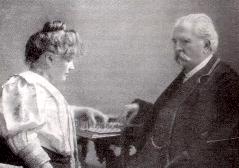 place of residence. Though he had continual success with his compositions, it was only in 1884 that he received an official appointment to the Dresden conservatory and with it, some financial security. In 1894, after receiving a professorship at the Royal Saxon conservatory, Draeseke at age 58 married his one time pupil Frida Neuhaus; the marriage was but all accounts harmonious and successful, a blessing to both until his death in 1913.
place of residence. Though he had continual success with his compositions, it was only in 1884 that he received an official appointment to the Dresden conservatory and with it, some financial security. In 1894, after receiving a professorship at the Royal Saxon conservatory, Draeseke at age 58 married his one time pupil Frida Neuhaus; the marriage was but all accounts harmonious and successful, a blessing to both until his death in 1913.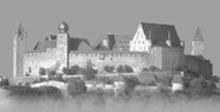 of Felix Draeseke (1966). Heinz Ebert and I lost contact after 1969 until 1992 when we met for the first time in his (and Draeseke’s) home town of Coburg that year. Meetings with Udo-R Follert and Helmut Loos followed and in the next year the
of Felix Draeseke (1966). Heinz Ebert and I lost contact after 1969 until 1992 when we met for the first time in his (and Draeseke’s) home town of Coburg that year. Meetings with Udo-R Follert and Helmut Loos followed and in the next year the  JAVIER PINELL
JAVIER PINELL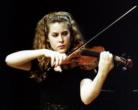
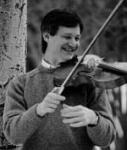 JAMES PRZYGOCKI
JAMES PRZYGOCKI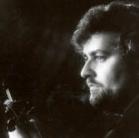 JOHN THOMSON, Professor of Violin/Viola at the University of South Dakota, appears as a guest artist with the Summit Chamber Players. He studied violin in New Zealand with David Nalden and is considered to be an expert on Gypsy violin music. He has performed as soloist with orchestras throughout the United States and New Zealand. Critics have referred to his playing as a rare treat. Thomason has performed before such dignitaries as Queen Elizabeth II, and former President George Bush.
JOHN THOMSON, Professor of Violin/Viola at the University of South Dakota, appears as a guest artist with the Summit Chamber Players. He studied violin in New Zealand with David Nalden and is considered to be an expert on Gypsy violin music. He has performed as soloist with orchestras throughout the United States and New Zealand. Critics have referred to his playing as a rare treat. Thomason has performed before such dignitaries as Queen Elizabeth II, and former President George Bush.